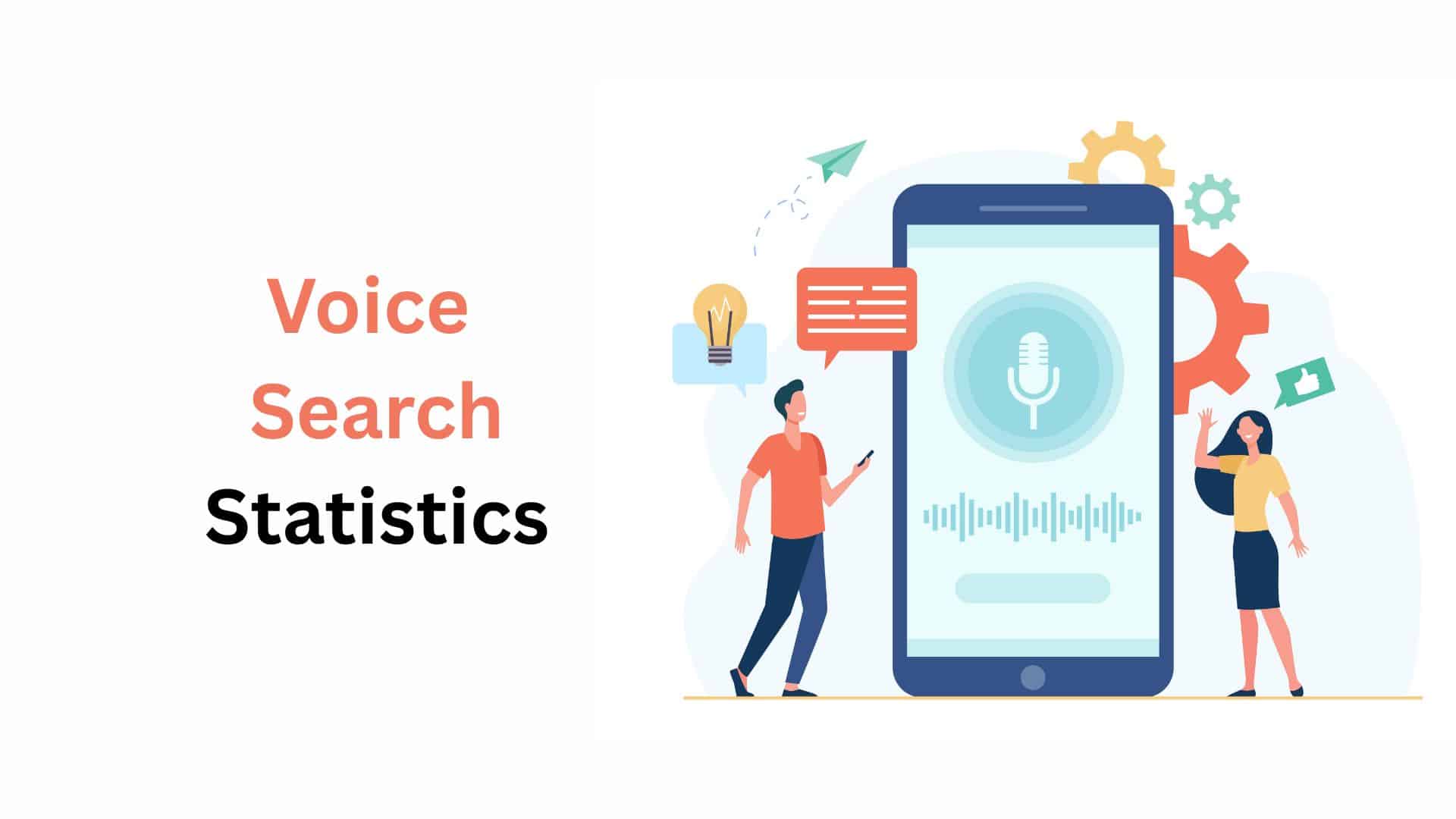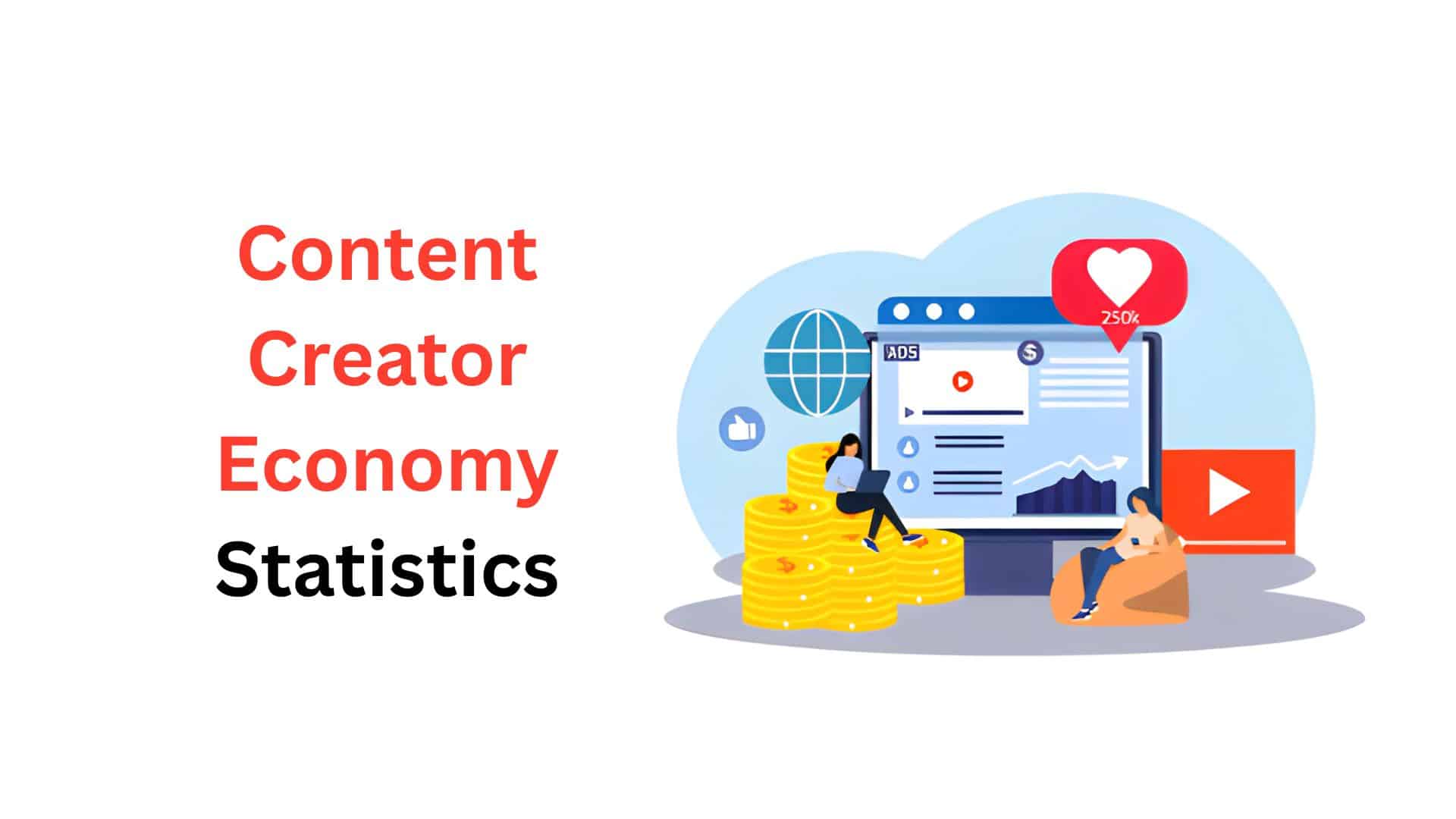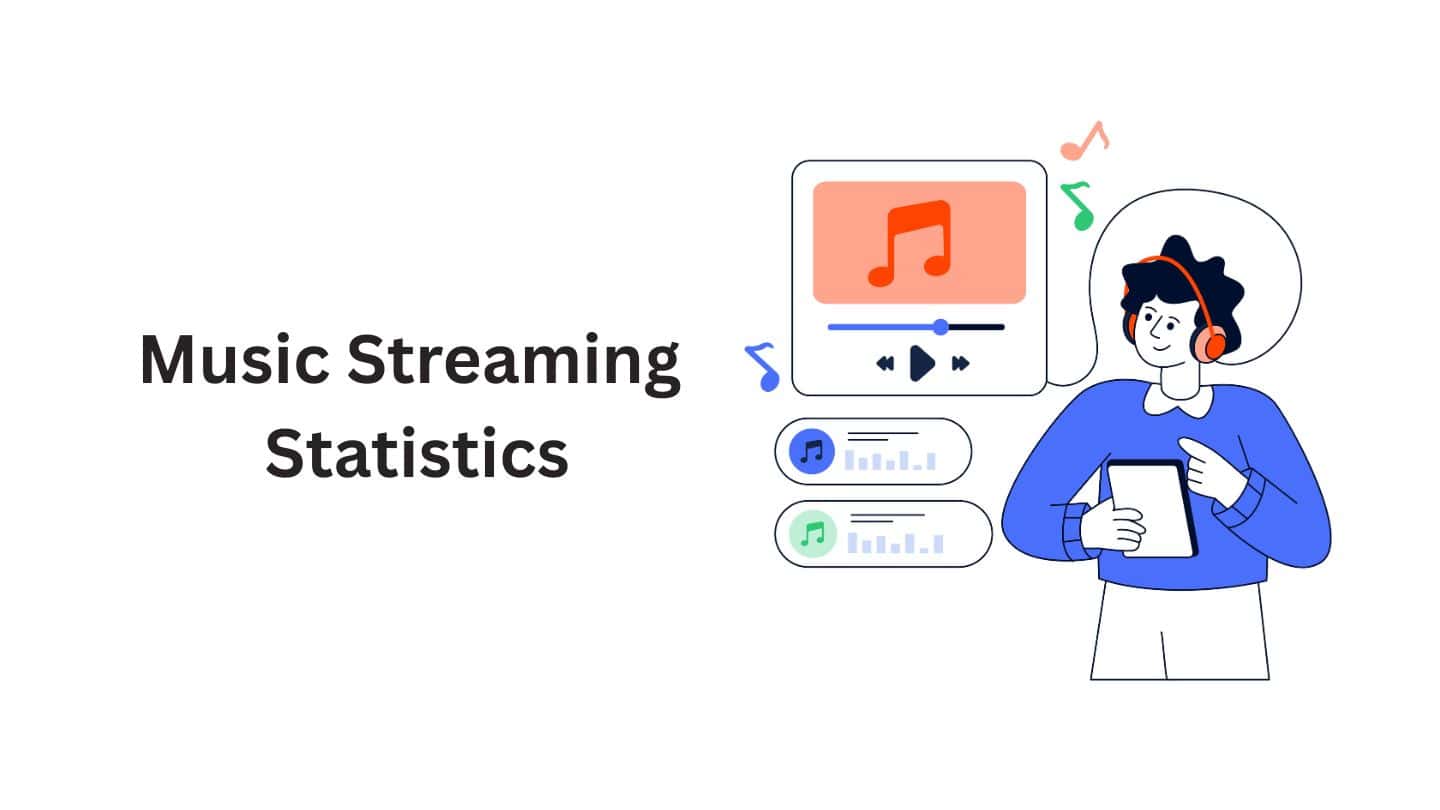iPhone Users Statistics By Regional, Demographics And Market Trends (2025)

Updated · Oct 07, 2025

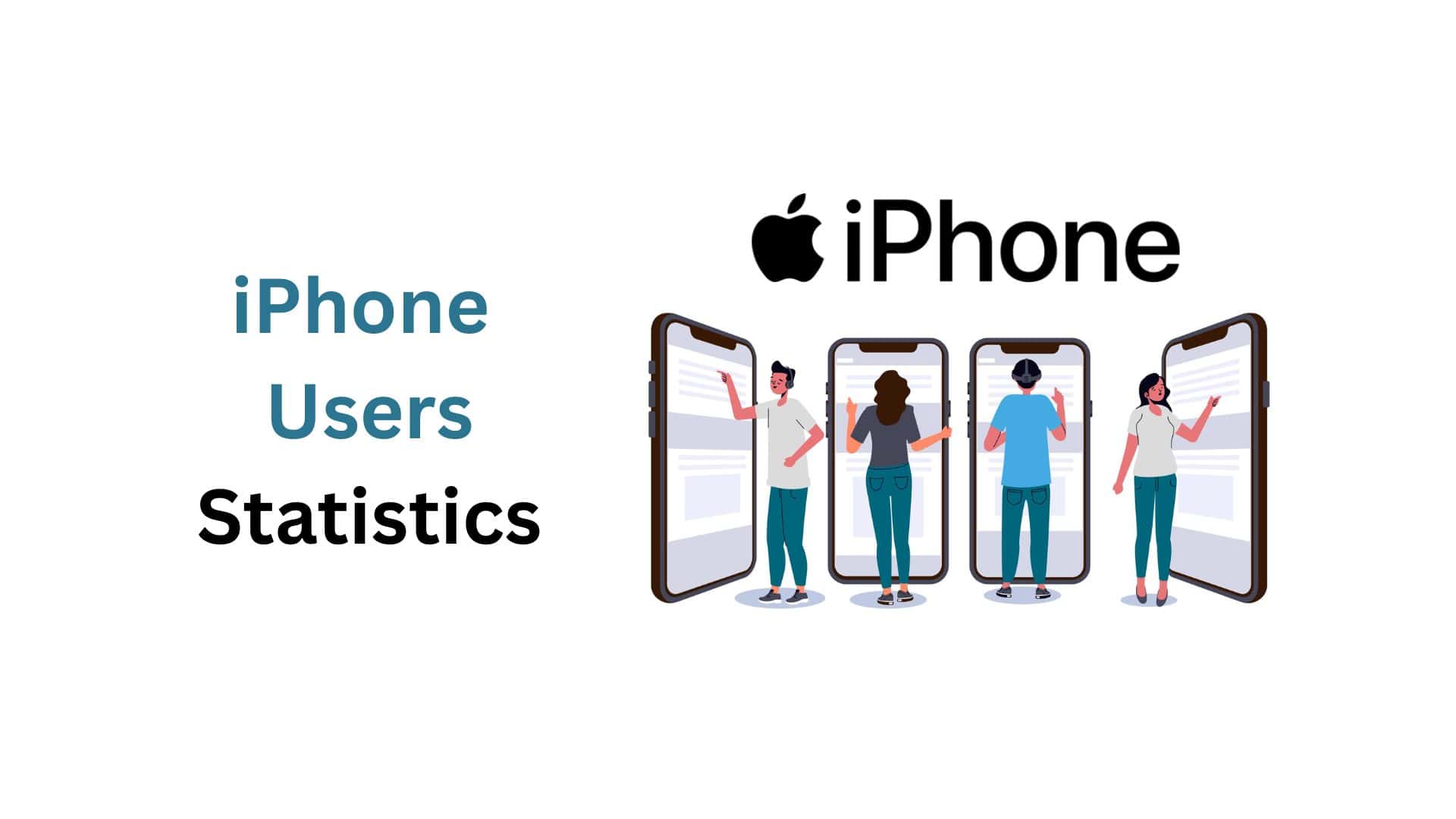
WHAT WE HAVE ON THIS PAGE
- Introduction
- Editor’s Choice
- Global Growth and Volume of iPhone Users
- Geographical Dominance and Regional iPhone Users
- Demographics and Socioeconomics of iPhone Users
- iPhone Users Market Size
- Phone Charger Market
- Loyalty and Ecosystem Stickiness for iPhone Users
- iPhone’s Financial Dominance and Revenue from iPhone Users
- Digital Behavior and App Spending of iPhone Users
- Conclusion
Introduction
iPhone Users Statistics: With the active installed base of iPhone users soaring past the 1.5 billion mark, Apple’s influence on the global consumer technology landscape is undeniable. It’s more than just a phone; it’s a cultural signifier, a secure ecosystem, a powerful engine for a nearly 400 billion dollar company. Apart from all, Apple remains a premium brand.
While Android controls he volume of the global smartphone market, the dedication, purchasing power, and platform loyalty of the average iPhone user create a level of unparalleled market value.
These data for 2025 give us a clear idea of a tech company solidifying its premium position, deepening its penetration in the world’s most lucrative markets, especially in India, and leveraging its software and services to turn device owners into lifetime customers.
In this comprehensive report, I’d like to discuss the figures behind the millions of daily activations, billions in revenue, and the demographic changes that are changing the global population of iPhone users. Let’s get into it.
Editor’s Choice
- The global active installed base of iPhone users is estimated to be over 56 billion units as of 2025, marking an impressive 7.1% increase from the previous year’s figure of 1.26 billion.
- The U.S. remains the most dominant single market, accounting for an estimated 7 million active iPhone users in 2025, a growth of over 5.2% YoY.
- Apple shipped an estimated 7 million iPhones globally in 2024, successfully capturing the title of the world’s leading smartphone vendor in the final quarter of that year.
- In the critically important U.S. market, iOS maintains a commanding majority, holding an estimated 24% share of the mobile OS market as of early 2025.
- The loyalty rate among iPhone users is exceptionally high, with over 90% of owners indicating they plan to purchase another iPhone for their next device upgrade.
- On a global average, iPhone users are projected to spend $142 billion on App Store applications and services in 2025, far outstripping the spending on the competing Android platform.
- iPhone users typically boast a higher average annual income, earning an estimated $85,000 per year, which is significantly greater than the $61,000 average reported for Android smartphone owners.
- The latest OS, iOS 18, achieved a rapid adoption rate, running on 7% of all active iPhones worldwide within months of its public release in March 2025.
Global Growth and Volume of iPhone Users
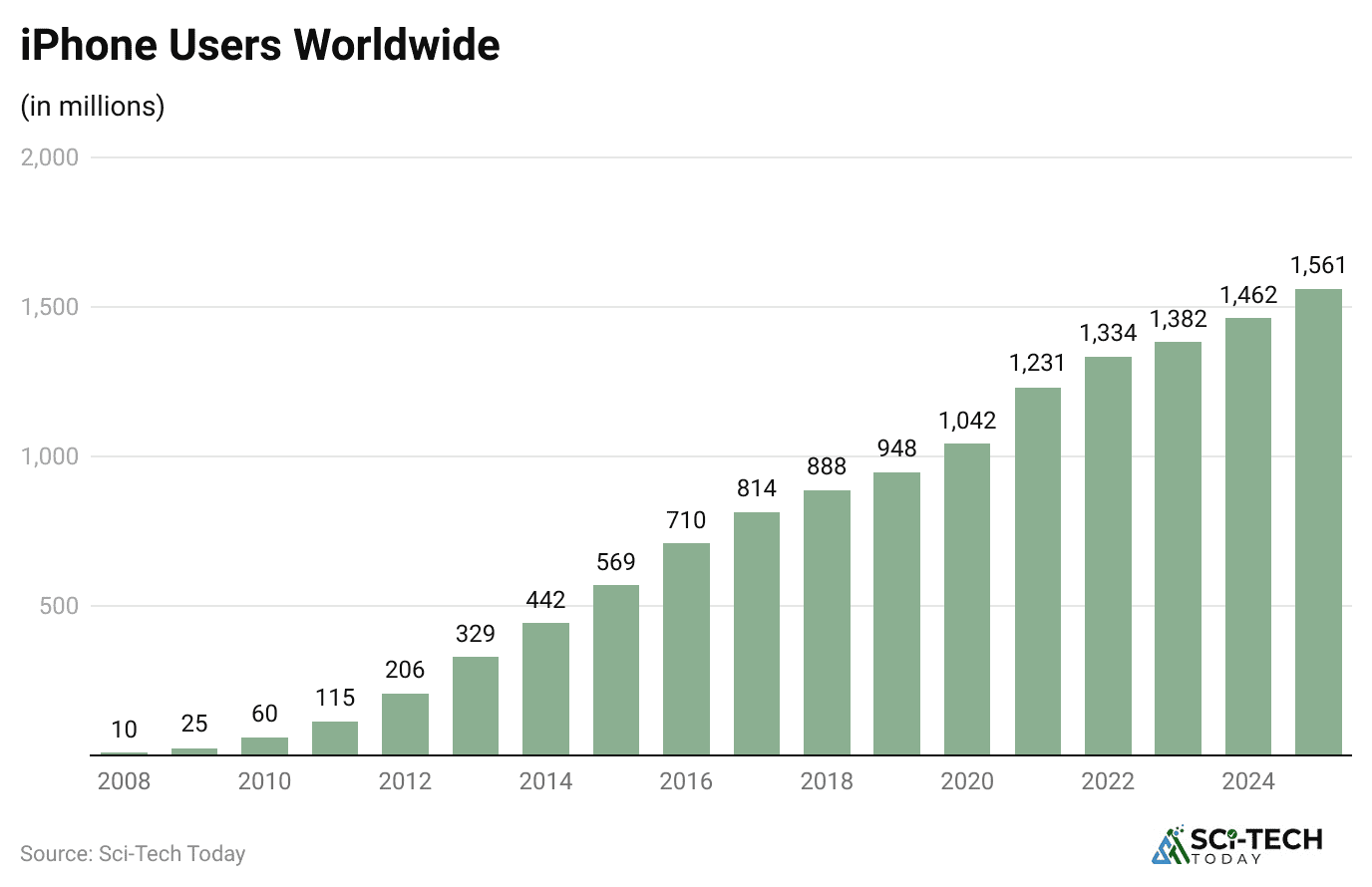
- The volume of active devices paints the most compelling picture of Apple’s success, demonstrating a consistent upward trend since the device’s 2007 debut.
- The total number of active iPhone users worldwide has reached an astonishing 1.561 billion units as of 2025.
- Apple first crossed the milestone of 1 billion active devices back in 2020, meaning the user base has expanded by over 56% in just 5 years.
- In 2024 alone, the active user base grew by an estimated 7.1%, adding approximately 100 million new or returning iPhone users to the global count.
- When looking at the global population, iPhone users now represent an estimated 19.08% of the world’s 8.18 billion people.
| 2025 | 1.561 Billion | +7.1% |
| 2024 | 1.462 Billion |
+7.2% |
|
2023 |
1.382 Billion | +3.6% |
| 2022 | 1.334 Billion |
+7.2% |
|
2021 |
1.23 Billion | +17.9% |
| 2020 | 1.04 Billion |
+9.1% |
Geographical Dominance and Regional iPhone Users
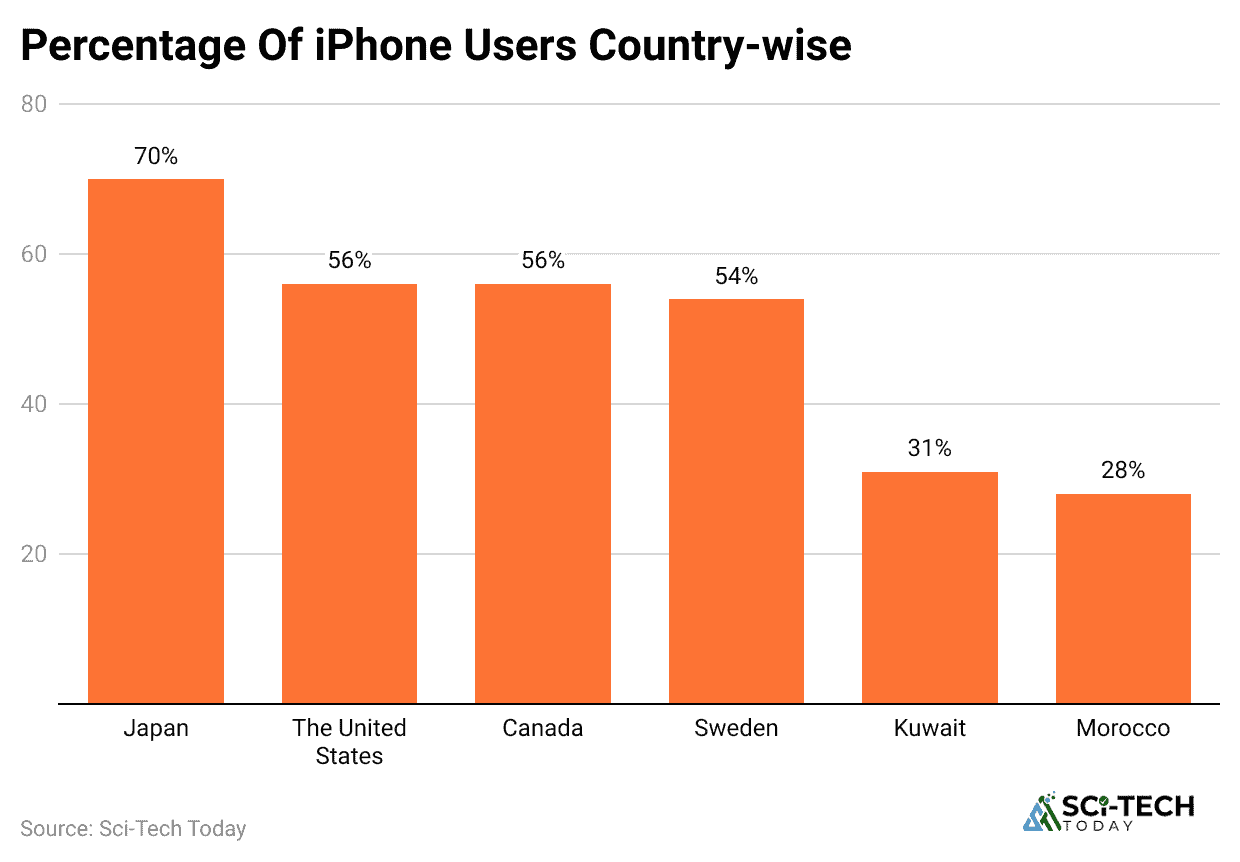
- The U.S. is home to an estimated 150.79 million iPhone users in 2025, which translates to a penetration rate of roughly 52.5% of all smartphone users in the country.
- In key Western markets, the preference for Apple is profound: Canada sees an iOS market share of 60.31%, while Australia and the U.K. follow closely with 59.63% and 52.29%.
- Japan stands out with one of the world’s highest iPhone penetration rates, with iOS controlling 68.86% of the mobile OS market.
- Conversely, massive emerging markets like India show the steepest challenge, where Android dominates with a 92% market share, leaving iOS with a small but rapidly growing share of only around 8%.
- Despite being the highest-priced model, the iPhone 16 Pro Max was the top-selling premium smartphone in the second quarter of 2025.
| U.S. | 57.24% |
| North America | 53.51% |
| Japan | 68.86% |
| Europe | 34.1% |
| Asia | 15.76% |
| India | 8% |
Demographics and Socioeconomics of iPhone Users
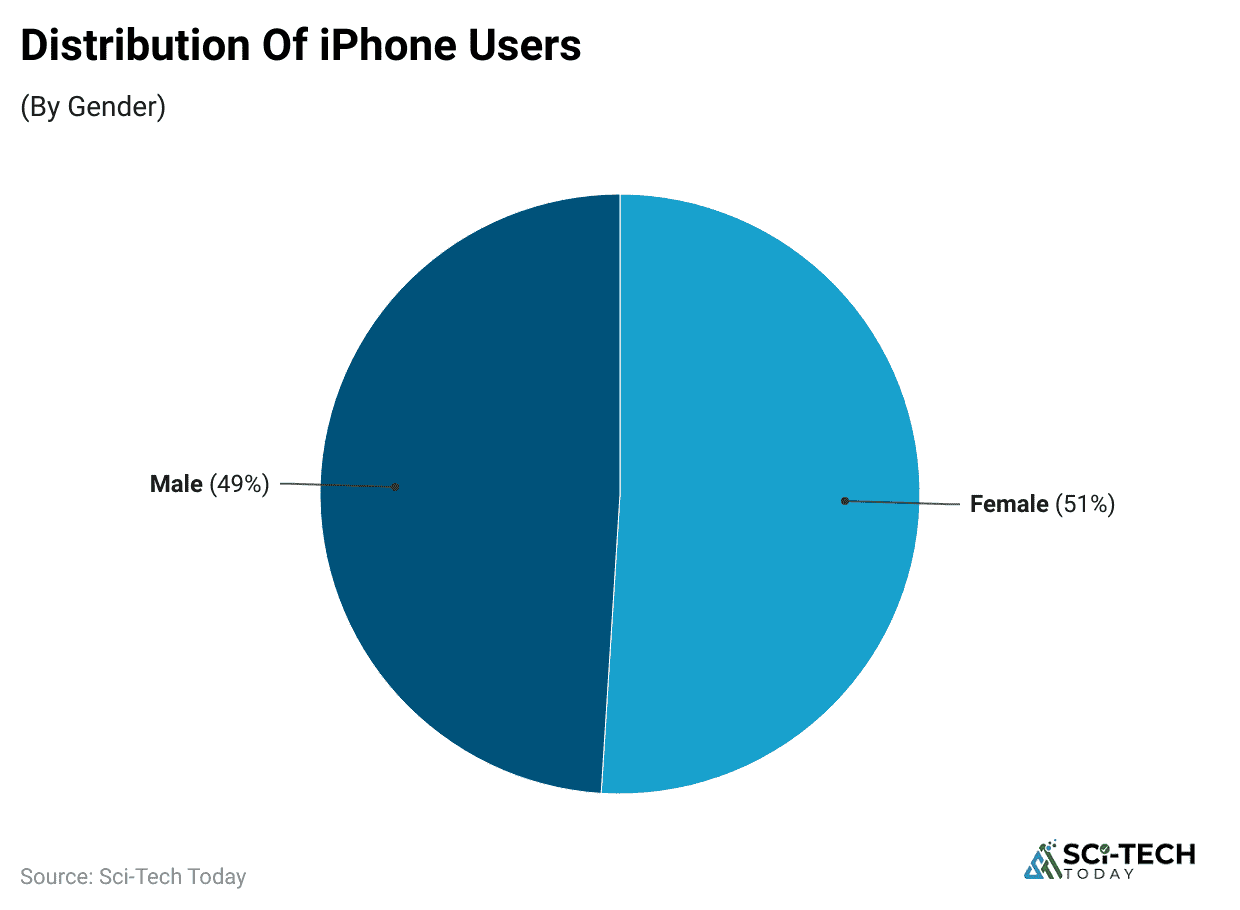
- The average annual salary of an iPhone user is reported to be around $85,000, which is substantially higher than the $61,000 average earned by a typical Android user.
- In the U.S., iPhone users earning over $125,000 per year are 48% more likely to own an iPhone than their Android counterparts.
- The key age demographic for iPhone users is the 25 to 34-year-old cohort, which makes up an estimated 23% of the total user base, followed closely by the 18 to 24-year-old group at 20%.
- Gen Z and Millennials are the most committed to the Apple brand, with a 2023 study showing that 58% of 18 to 34-year-olds in the U.S. use an iPhone as their primary device.
- iPhone users are significantly more active with their devices daily, spending an average of 4 hours and 54 minutes of screen time, compared to the lower average of 3 hours and 42 minutes reported for Android users.
- In terms of gender distribution, 31% of iPhone users globally identify as female, slightly higher than the 28% who identify as male, indicating a small but consistent preference among women worldwide.
| 25 to 34 years | 23% |
| 18 to 24 years | 20% |
| 35 to 44 years | 20% |
| 55+ years | 21% |
| 45 to 54 years | 16% |
iPhone Users Market Size
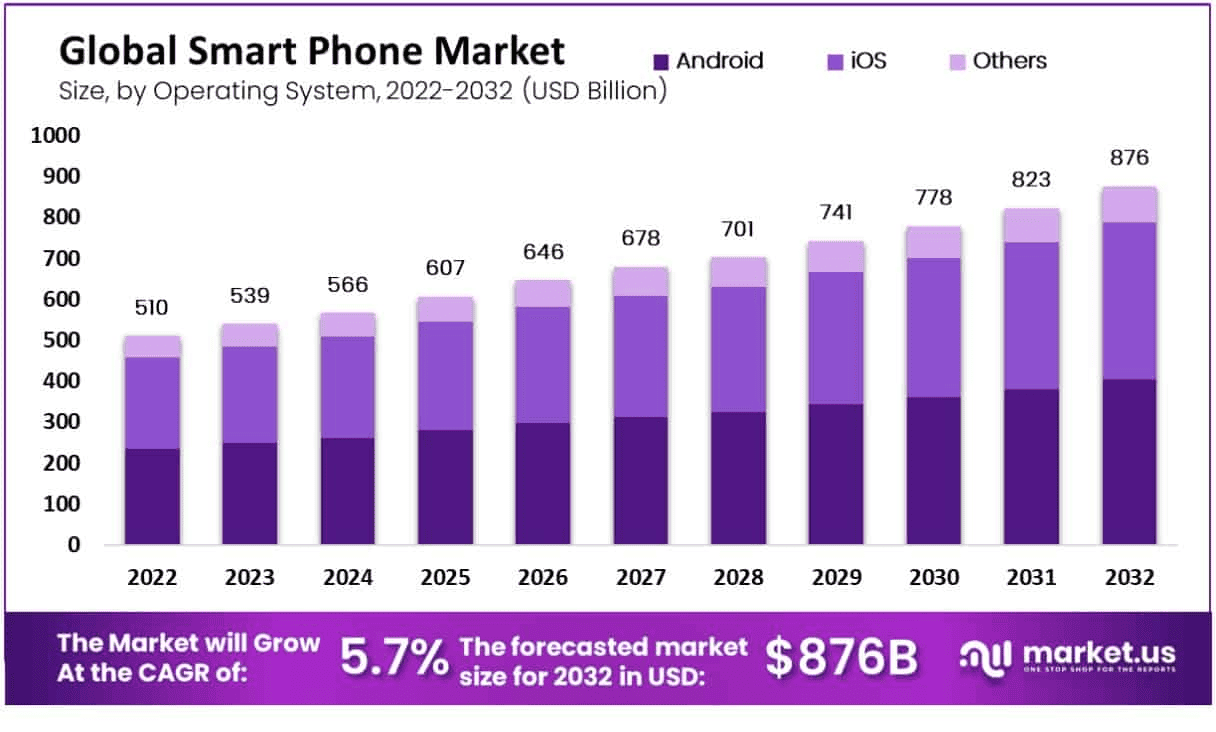
- According to market.us, the global smartphone market is set to nearly double, jumping from $570.3 billion in 2024 to a projected $939.2 billion by 2033. (a 5.7% annual growth rate.)
- The boom is powered by new technologies, the need for constant connectivity, and more people buying smartphones in developing countries.
- Android is the leading OS globally, holding a 63.4% market share due to its open-source flexibility.
- Most consumers (47.6% share) buy their phones directly from the manufacturer’s own stores (OEM stores).
- North America holds the largest market share by value (42.6%), driven by high demand for premium phones and the fast adoption of 5G.
- Adoption of 5G is accelerating rapidly. By 2024, 45% of all active smartphones (a projected 5.3 billion devices) are expected to be 5G-ready, up from just 15% currently.
- Samsung currently dominates the market, selling over 60 million smartphones in Q1 2024, but faces strong pressure from brands like Xiaomi, which saw a 27.4% increase in shipments.
Phone Charger Market
- The phone charger market is predicted to grow significantly, from $18.8 billion in 2025 to $30.4 billion by 2034 (a 5.5% annual growth rate).
- This growth is a direct result of the massive increase in smartphone use globally and the push for faster and more efficient charging solutions (like fast and wireless charging).
- Despite the buzz around wireless, Wired charges still lead the market with over 51.0% market share, favoured for their reliability.
- The offline channel (physical stores) dominates sales, accounting for more than 80.0% of the market.
- The general charger is the most common product sold, capturing over 52.0% of the market, showing strong demand for basic, universally compatible options.
- The Asia-Pacific region leads the global charger market with a 41.4% share, driven by a large population and high mobile device usage.
- Industry best practices recommend keeping lithium-ion batteries between 20% and 80% charge for peak efficiency and longer life.
- Modern charges are designed to automatically stop at 100% to prevent damage.
| Market Value Growth (Smartphone) | Jumps from $570.3 (2024 to $939.2 (2033) |
| Smartphone Growth Rate | 5.7% (CAGR) |
| Market Value Growth (Chargers) | Jumps from $18.8B (2025) to $30.4B (2034) |
| Charge Growth Rate | 5.5% (CAGR) |
| Leading OS | Android leads at 63.4% |
| Top Sales Region (by value) | North America holds 42.6% of the market value |
| Top Charger Region (by volume) | Asia-Pacific leads at 41.% |
| Current Market Leader (Brand) | Samsung sold over 60 million units (Q1 2024) |
| Future 5G Adoption | Expected to hit 45% |
| Most Popular Charger Type | Wired segment leads at over 51.0% |
| Top Distribution Method | Offline (In-Sote) accounts for over 80.0% |
| Battery Health Best Practice | Keep charge between 20% and 80% |
Loyalty and Ecosystem Stickiness for iPhone Users
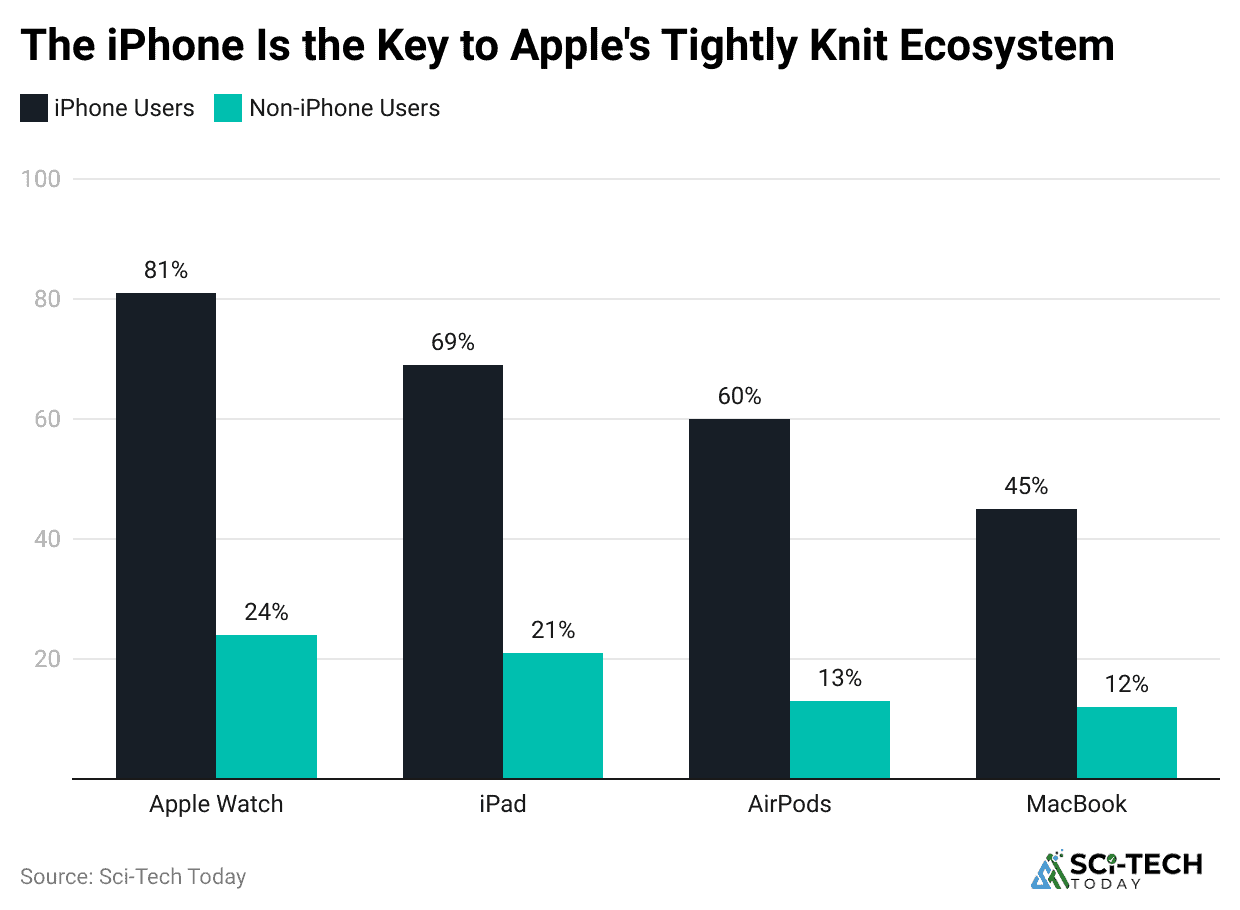
- Customer retention rates for the iPhone are remarkably high, consistently hovering over 90%, meaning 9 out of every 10 iPhone users choose to purchase another iPhone.
- In contrast, loyalty rates of Android devices typically range between 70% and 80%, underscoring the distinct competitive advantage Apple holds.
- Switching data shows that 18% of current iPhone users are former Android device owners, whereas only 11% of current Android users have switched from iPhone.
- The average lifespan of an iPhone before trade-in is also longer; a significant 29% of iPhone users keep their devices for 3 years or more, compared to only 21% of Android users.
- The “ecosystem effect” is powerful: approximately 79% of iPhone users in the U.S. also own an Apple Watch, illustrating the successful strategy of tying users into a multi-device product family.
| Retention Rate (Next Purchase) 90% | 70% to 80% |
| % of users who switched to the platform | 18% (from Android 11% (from iPhone) |
| % of users who keep the device for 3 years | 29% |
| Ecosystem Ownership (U.S. Apple Watch) | 79% |
iPhone’s Financial Dominance and Revenue from iPhone Users
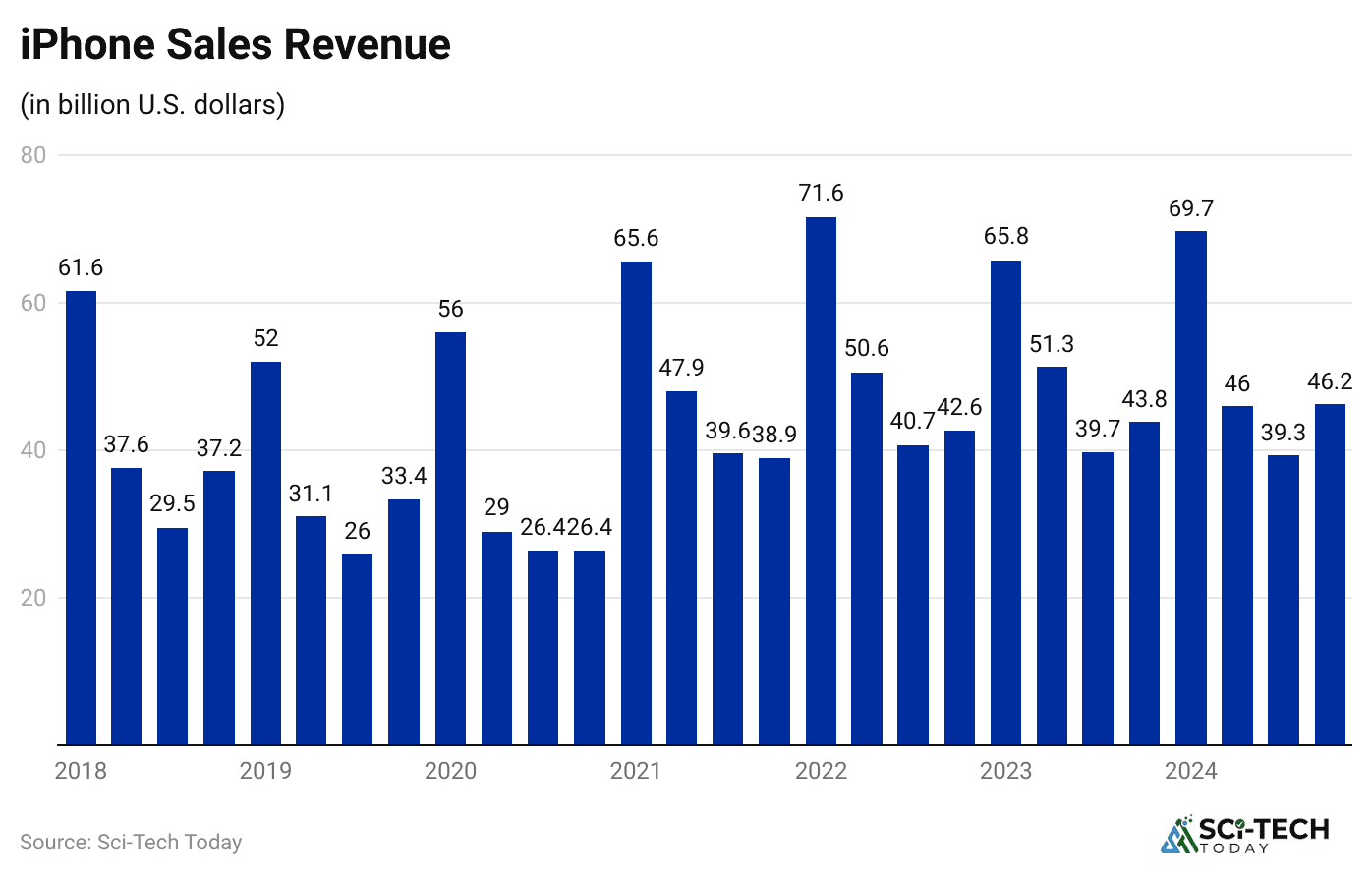
- For its fiscal year 2024, the iPhone generated an estimated $201.1 billion in revenue, which accounted for 51.4% of Apple’s colossal total annual revenue of $391.04 billion.
- In the 3rd quarter of fiscal year 2025 (Q3 2025), iPhone sales saw a strong YoY jump, contributing $44.6 billion in revenue and representing a substantial growth of 13.5% in the quarter.
- The services segment, which includes the App Store, Apple Music, and iCloud, directly made by the iPhone user base and generated a record $27.4 billion in Q3 2025 alone, up 13.3% from the prior year.
- Consumer spending on the App Store by iPhone users is projected to hit $142 billion globally in 2025, a massive figure that is more than double the $65 billion projected for the Google Play Store.
- On average, an iPhone user spends an estimated $12.77 on each application they purchase or engage with, which is significantly higher than the average expenditure of $6.19 per app recorded for Android users.
- The cumulative revenue from the Apple Store since its launch in 2008 has now surpassed an estimated $350 billion, almost entirely sourced from the spending habits and in-app purchases of iPhone users globally.
| Fiscal Period | Total Apple Revenue (Billions) | iPhone Revenue (Billions) | iPhone’s % of total revenue |
| FY 2024 | $391.04 | $201.1 | 51.4% |
| FY 2023 | $383.29 | $200.58 | 52.3% |
| Q3 2025 | $94.0 | $44.6 | 47.4% (Quarterly) |
Digital Behavior and App Spending of iPhone Users
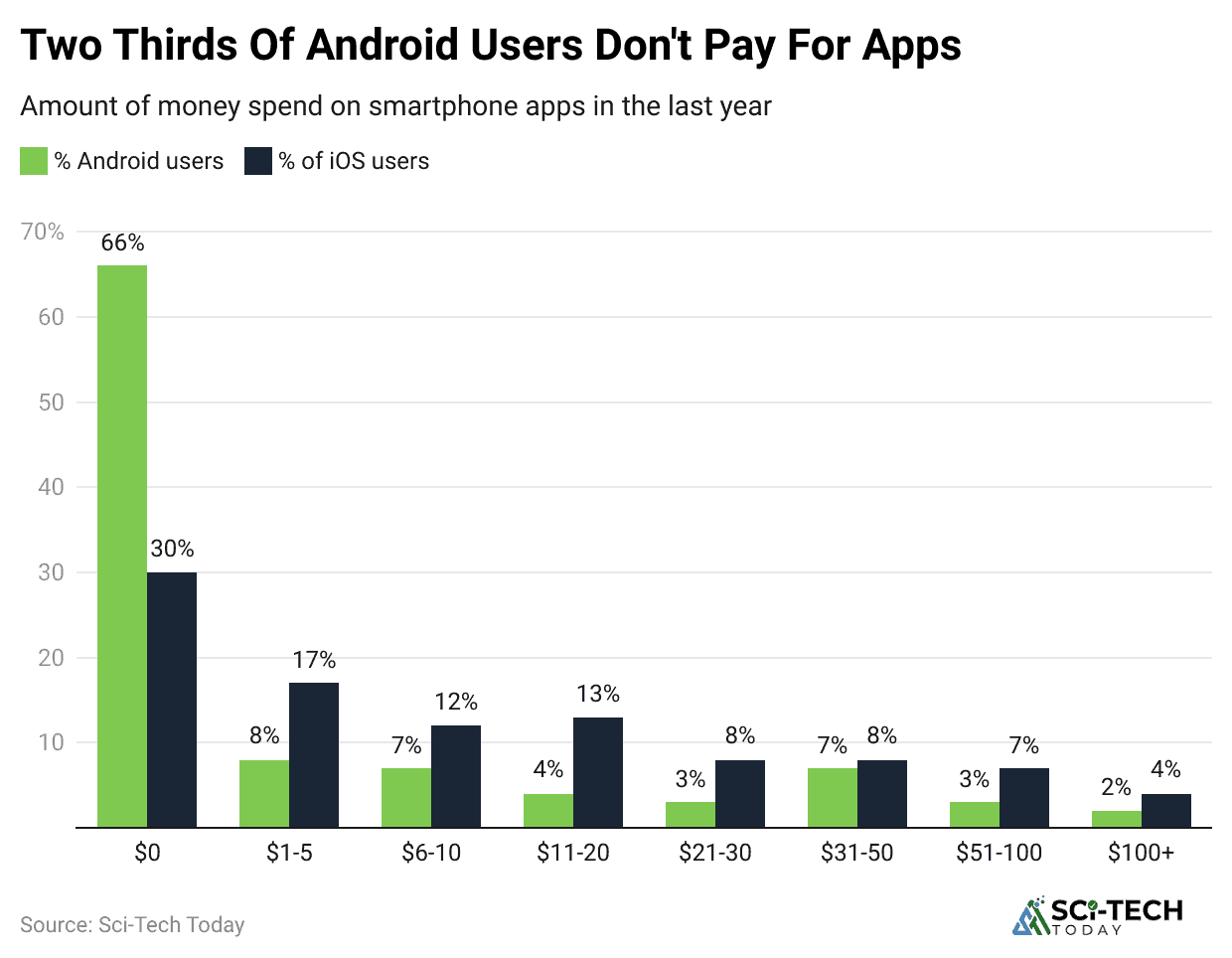
- The average transaction value for in-app purchases on the App Store is approximately $1.07, which is more than double the $0.43 average recorded for comparable purchases on the Android ecosystem.
- In February 2025, the new AI-focused app DeepSeek was the most downloaded app on the App Store, generating a colossal 21 million downloads globally, illustrating the high engagement of the iPhone user base with tech.
- The highest-grossing app on the iPhone platform, DouYin (the Chinese version of TikTok), generated an estimated $372.08 million in revenue in June 2023 alone.
- In the U.S., iPhone users are markedly more comfortable with advanced security features; for example, 77% are more likely to actively monitor location tracking in their applications compared to 68% of Android users.
- A behavioral statistic shows that the average iPhone user sends an estimated 58 text messages every single day, more than doubling the 26 daily texts typically sent by Android users.
| App Metric | App Store (Driven by iPhone Users) | Google Play (Comparative) |
| Projected Consumer Spending (2025) | $142 Billion | $65 Billion |
| Average Transaction Value (In-App) | $1.07 | $0.43 |
| Average Spend Per App (Lifetime) | $12.77 | $6.19 |
| Most Download App (Feb 2025) | DeepSeek (21 million downloads) |
Conclusion
Overall, these iPhone user statistics 2025 don’t just reflect a successful device lineup; they confirm the existence of a high-value, highly engaged, and incredibly loyal global consumer segment. With an active base surpassing 1.56 billion units and a retention rate exceeding 90%, the iPhone is Apple’s financial engine, consistently driving over half of the company’s multi-billion dollar revenue.
The distinct demographic profile, marked by higher incomes and younger adoption rates, ensures that this user base is not only large but also the most profitable in the mobile industry, as demonstrated by the $142 billion they are projected to spend on App Store content this year. Thanks for staying up till the end, and I hope you like this article.
FAQ.
There are over 1.5 billion active iPhone users around the world; that’s a huge number.
No, while the iPhone is very popular, Android is used by many more people globally. This is because many different companies make Android phones, offering many more choices and lower prices. Android has about 70% of the global smartphone OS market, while Apple’s iOS has about 27%.
Yes, in the U.S. and Canada, the iPhone is typically more popular than Android.
- In the U.S., about 57% of smartphone users have an iPhone.
- About 43% of U.S. smartphone users have an Android phone.
Yes, iPhone users are known for being very loyal.
- A very high number (often over 90%) of current iPhone owners choose to buy another iPhone when they upgrade.
- This loyalty is often because they love how easy it is to use all Apple products together (the Apple “ecosystem”, the design of the phones, and the feeling that their phone is secure).
The most searched-for problems are usually about getting locked out of their phone or having trouble with common features:
- iPhone is disabled. Connect to iTunes (This happens if you enter the passcode wrong too many times).
- Forgot iPhone password or forgot iPhone passcode
- Face ID is not working
- iPhone not charging

Barry is a technology enthusiast with a passion for in-depth research on various technological topics. He meticulously gathers comprehensive statistics and facts to assist users. Barry's primary interest lies in understanding the intricacies of software and creating content that highlights its value. When not evaluating applications or programs, Barry enjoys experimenting with new healthy recipes, practicing yoga, meditating, or taking nature walks with his child.
